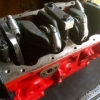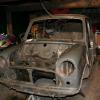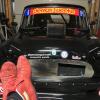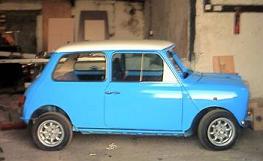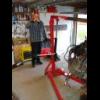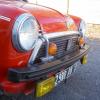Best Answer
tiger99
,
26 November 2016 - 12:19 PM
One modern European car was a downright disgrace. BMW E36 Z3, 5,600 Nm/deg on a good day with no rust. About as stiff as a tea tray. That set the alleged high quality manufacturers off on a ridiculous quest to achieve needlessly high numbers, to outdo one another. But the real measure of a successful design is the torsional resonant frequency, because it takes into account the vehicle mass. A lightweight car like the Mini does not require a stupidly high torsional stiffness, but should achieve as high a resonant frequency as a heavyweight. It is likely that the Mini is much better in that respect than certain ladder-chassis SUVs.
This site http://blogs.youwhee...rehensive-list/
is largely confined to cars available in the USA but gives some interesting numbers. Not many classic cars, and those ladder chassised abominations with "torsion boxes" (which were a frequent source of structural cracking) would have scored very low indeed.
This link http://www.minimania...Body_Dimensions (please bookmark that site for future reference)
gives the numbers you are all waiting for, and as expected the saloon is ahead of the van due to the opening rear doors and lack of rear bulkhead. I have converted them for a direct comparison with modern stuff. That is 11,460 Nm/deg for the saloon and "only" 9,320 Nm/deg for the van. Very adequate for a lightweight car!
I don't have access to the torsional resonant frequencies and can't calculate them as they depend on mass distribution. But what i can say is that Alec knew exactly what he was doing!
If making a convertible, you will not get back to the original stiffness by adding box sections in the sills only, and you will have to be careful not to get problems where thick metal joins thin, which is not to sat that you should not do it to improve bean (bending) strength. A bit too low to add useful side impact protection.
The late LJK Setright, possibly the only truly competent motoring journalist of last century (and we seemingly don't have any now!), used to consider that for a road car 5000 to 10000 lb ft/deg was ample. So the Mini's 8,450 in real units was well within the upper range of what he considered to be adequate.
I can't find the figure for the old A35 right now, but it was up in silly supercar numbers, designed by ex-aircraft people, as was the 1800 Land Crab, designed by Alec.
But please be aware that torsional stiffness degrades quite badly when parts of a monocoque which are only carrying secondary loads are corroded, because they allow the primary structure to flex more, and bulge under compressive loads. And I don't doubt that oversills will send it way down. After a proper restoration, with welds located in the correct places, it will be as original, or maybe even better if you have seam welded where only spots were used originally.
I am very interested in stiffness figures for classic cars, so if you have any, this might be a good place to post them, so we can all be enlightened, and see just how good our Minis really are.
But to return to the original question, you certainly do not need to connect the front and rear subframes other than via the standard monocoque. You would be hard pressed to make much difference anyway unless you used a cruciform box section like old Rolls Royces, etc, or a true triangulated space frame. It is hard to improve good things.
Go to the full post 





